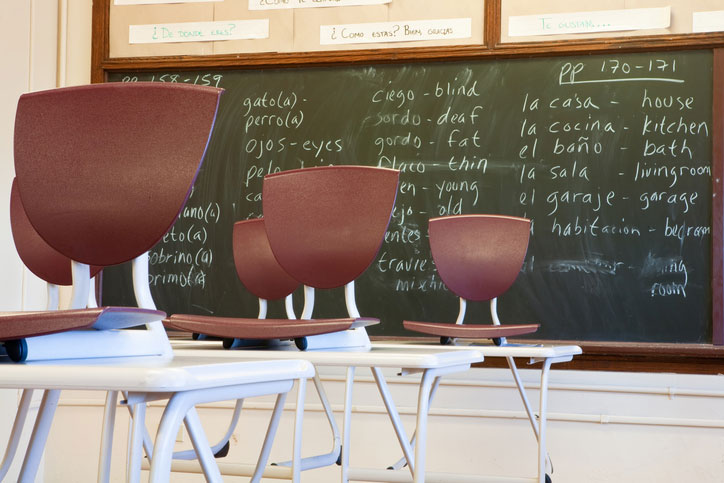What Is ESL?
Anyone who has lived in a foreign country knows that life is more difficult if you don’t speak the native language. For those who are migrating to a place that uses an unfamiliar language, it can be alienating, intimidating, and overwhelming. Though there are communities in the United States that speak languages other than English as their primary language, English remains the majority and official language of the U.S., meaning that many who do not grow up speaking the language learn it later in life. This is why ESL classes are so popular, leading to important breakthroughs for people all over the country.

So what is ESL?
ESL classes teach the fundamentals of communicating in English, including reading, writing, speaking, and listening.
Mastering these skills can be invaluable for people looking to succeed in the United States. This is as true in school, where fluency in English can be required to understand the material, as in work, where written and verbal communication can be central to the job. It’s easy to understand why finding high-quality, effective ESL classes is a top priority for so many people.
ESL programs provide courses in English tailored to students’ level of fluency. Beginner classes teach the basics of English while more advanced classes help students understand smaller nuances in the language that can help people communicate and apprehend the language with greater precision.
There are many demographics of people who take ESL classes, regardless of age. This article looks at approaches to ESL programs in public schools as well as private ESL programs, some of which cater primarily to adults.
ESL Program Structure
Because there are so many people who need to build their English skills, there are a variety of ESL program structures that aim to meet English language learners where they are. This extends not only to their level of proficiency but to the setup of their life. Despite the great need to learn the native language of one’s country of residence, it’s not always easy to find the time to do so. Below is an overview of a few of the options that make it possible to learn English alongside navigating many other responsibilities.

ESL Programs in Public Schools
What is ESL in a school setting?
For students who have just arrived in the United States, acclimating to the language barrier can significantly impact one’s academic performance as well as their ability to socialize.
To help accommodate the average student’s demanding school schedule, ESL programs are built into many high schools’ academic offerings.
So what is an ESL class?
It depends. Some ESL programs are discrete classes that are built into students’ schedules, often taking the place of other foreign language classes that they would otherwise be taking. Beyond teaching curriculum that directly builds English skills, these classes also typically help students learn English while completing their homework at the same time.
In some schools, ESL programs are even more integrated into academic subjects in combined programs that teach English as a second language in combination with other classes. These classes can include science, history, math, and literature. In the last case, ESL courses are focused on the subject of English literature at a level that is accessible to English language learners.
Private ESL Programs
What is ESL in a private setting?
For those who are out of school or not attending schools that offer ESL courses, private programs are available to offer a comprehensive education.
These can be an excellent option for those who wish to learn English quickly.
One draw of private programs is that they offer a great variety to accommodate the many different needs of English language learners. On the extreme side, programs for those who don’t live in the United States can feature homestay opportunities that are completely immersive. On the practical side, there are virtual programs that meet on weekends and at night to accommodate the schedules of those who are working and managing their day to day lives while learning English.
Beyond Private programs can also focus on specialized subjects, including the following:
- Conversational English
- English for business and the workplace
- English for other particular professions
- Reading and writing
- Elementary and high-school level English for students who don’t have ESL programs in their schools
These course offerings make it possible for English language learners to focus on the skills that will best suit their immediate needs. For those who are working full-time, specialized ESL courses can be a game changer, making an otherwise unmanageable schedule doable and effective.
Beyond classes, ESL tutoring is available on a one-on-one basis to offer truly individualized coursework for people in all sorts of situations. These can be remedial courses for people who have already taken ESL classes in the past but want to brush up on their skills, academic tutoring for students in elementary, high school, or college, conversation practice, and more. For those who are able to make the time and afford the expense, a one-on-one tutor is a fantastic way to get a personalized education in English.

ESL Exercises
ESL teachers rely upon a variety of strategies to teach the language while keeping students engaged. Because there are ESL classes for people of all ages and with the variety of specialties listed above, the coursework for ESL classes can vary greatly.
Here are just a few of the methods ESL teachers use to help students access the material.
ESL Games
Especially when working with children, games can be an exciting and helpful way for students to learn material that might otherwise be daunting or overwhelming to them. They can also open up opportunities for students to communicate with one another in English who might otherwise be intimidated to start a conversation in a language not their native tongue.
Below are just a few of the best ESL games to engage young people.
Two Truths and a Lie
This group activity, which is likely to be familiar to all, is a terrific icebreaker activity that naturally calls upon students to speak English to carefully craft statements for everyone to understand. For those unfamiliar, the concept is simple: each person in the group shares two true facts about themselves and one lie. The rest of the group votes on which one they think is the lie. This is an especially great game to play in an introductory context as long as students are speaking at an intermediate level or higher. To help build multiple skills at once, it can be helpful to have the students write out their answers before sharing them aloud. This can also give you something to review and correct as needed.
Pictionary
This is another great game that suits all skill levels. We’ve all played it: players pull a word or phrase from a hat and draw it on a whiteboard as their fellow teammates attempt to guess what they are drawing. In ESL classes, of course, the guesses must be made in English. This is a fun way of creating a little playful competition in the classroom while introducing key vocabulary words.
Hot Seat
This popular game, which is similar to Taboo, is another great way of building student vocabulary. One student sits in front of the class with their back to the whiteboard, upon which a word or phrase is written. The rest of the class helps them guess what’s written on the board without using that word or phrase. In an ESL class, all hints must be given in English, building the skill for both the listener in the hot seat and those who are giving suggestions.
Simon Says
This is another classic game that is well suited to an ESL setting. In more advanced classes, students can lead the exercise, giving them the opportunity to practice their speaking skills. In beginner classes, the teacher can lead the exercise, giving students the opportunity to practice their comprehension. Though most would associate this game with an early elementary school setting, in an ESL context it is useful for students of all ages.
ESL Vocabulary Exercises
There are many tools used to help students build their vocabularies in English. Here are a few of the most popular vocabulary exercises for ESL students.
Matching exercises
These can involve pictures, translations into the student’s first language, flash cards, word banks, and more. These can be excellent to assign as homework for students to review key vocabulary words outside of the classroom.
Fill-in-the-blanks exercises
These can be a fun and useful way to help students understand the context for key vocabulary words, possibly even giving them memorable stories to help reinforce their verbal skills. To add some humor and spontaneity into the mix, you can create Mad Libs style activities that let students pick their own answers to fill in the blanks.
Crossword Puzzles
This is another simple and fun way to build vocabulary. For beginners, hints to each word can be given in the students’ native language, while for intermediate and advanced students, hints can be written in English too, making for a more comprehensive exercise.
Labeling Exercises
This is a useful exercise when learning vocabulary sets that can be connected to a single image, with various parts to be labeled. This is especially helpful for visual learners, who will have an easier time memorizing the material with pictorial cues. Some ideas for images include:
- Cross-sections of houses
- Rooms filled with furniture
- Closets
- The body
- Scenes of nature
- Grocery stores
- Classrooms
For more information on exercises and games ESL teachers can bring into the classroom as well as other strategies for teaching effective classes, take a look at our ESL Toolkit.
How to Find an ESL Program
With so many options available for English language learners, it should not be difficult to find ESL classes in most parts of the United States as well as abroad. The question is of finding the right class to suit one’s particular needs, from skill level to subject matter to scheduling.
If you are helping an English language learner find the program that’s right for them, here are some of the best questions to ask:
- How good is your spoken and written English?
- Are there ESL programs available where you study or work?
- What is ESL going to do for you? Is there a particular set of vocabulary you need to know in order to do your current or intended job?
- Is there a particular skill you would like to improve?
- How much time for ESL classes can you fit into your schedule?
- When is the best time for you to take classes?
These will determine the appropriate course of action for ESL courses, ensuring that
students receive the best education possible at a pace that they can actually sustain.
Taking the Next Steps to Become an ESL Teacher
ESL teachers can make an enormous difference in the lives of people who are transitioning to a foreign environment. Whether working with young people who are navigating a language barrier on top of academic stresses and overall acclimation to working with adults who are eager to make the most of their professional lives, ESL teachers and tutors can help people build a skill that will change their lives and open up new access to the English-speaking world. You’ll be able to answer the question “What is ESL?” with new knowledge about how meaningful of a program it can be.
If you are interested in learning more about the positive impact ESL teachers can have on their students, take a look at our article “Why Teach ESL?”
